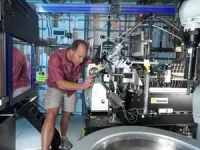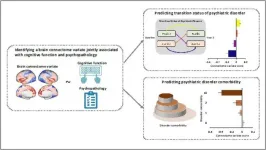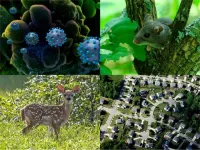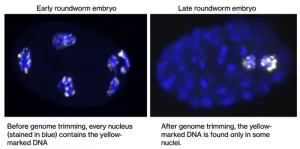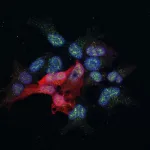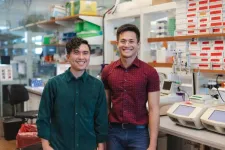The COVID Moonshot initiative started as a spontaneous virtual collaboration in March 2020, when a group of scientists and students from academia and biopharma, triggered by a Twitter appeal, joined forces to begin a race against the clock to identify new molecules that could block the SARS-CoV-2 virus. This unprecedented, crowdsourced, and fully open collaboration of more than 200 scientists, rapidly identified and developed novel compounds with excellent antiviral activity against a key enzyme of the SARS-COV-2 virus, namely the main protease (Mpro). The lead candidate is now in pre-clinical evaluation in collaboration with the Drugs for Neglected Disease initiative (DNDi). The COVID Moonshot is dedicated to the discovery of safe, globally affordable antiviral drugs against COVID-19 and future viral pandemics, and is pioneering a straight-to-generic, patent-free approach.
The consortium’s paper reports on the discovery of a non-covalent, non-peptidic inhibitor scaffold with lead-like properties that is differentiated from current main protease inhibitors. Their approach leveraged crowdsourcing, machine learning, exascale molecular simulations, and high-throughput structural biology and chemistry. It built on data from a large experiment, performed in record time at the start of the pandemic, at Diamond Light Source’s XChem facility for crystallographic fragment screening using Diamond’s high-throughput crystallography. In the experiment, 1,495 fragment-soaked crystals were screened within weeks to identify 78 hits that densely populated the enzyme’s active site.
The team were able to generate a detailed map of the structural plasticity of the SARS-CoV-2 main protease, extensive structure-activity relationships for multiple chemotypes, and a wealth of biochemical activity data. All compound designs (>18,000 designs), crystallographic data (>840 ligand-bound X-ray structures), assay data (>10,000 measurements), and synthesized molecules (>2,400 compounds) for this campaign were shared rapidly and openly, creating a rich open and IP-free knowledge base for future anti-coronavirus drug discovery.
By making all data immediately available, with all compounds purchasable from the Ukrainian chemistry supplier Enamine, the consortium aims to accelerate research globally along parallel tracks following up on their initial work. “The data set enclosed in the Science publication provides a unique resource linking comprehensive structural data, fragment hits, multiple chemical scaffolds, as well as biochemical and cellular assay data that can be viewed and exploited by other scientists”, states Dr Lizbe Koekemoer, one of the lead authors and a team leader at the Centre for Medicines Discovery, University of Oxford.
“This is the first time such a large number of protein-ligand structures have been generated for a drug discovery campaign and released in the public domain. It is a testament to Diamond’s high-throughput crystallography infrastructure, but also the astonishing coordination across many research groups world-wide under enormous pressure”, adds Dr Daren Fearon, another lead author and Senior Beamline Scientist at Diamond Light Source, who leads the XChem facility.
As a striking example for the impact of open-science, the Shionogi clinical candidate S-217622, which is available in Japan under emergency approval as Xocova [ensitrelvir], was identified using the data generated at Diamond and openly released. Senior author Prof Frank von Delft, Principal Beamline Scientist at Diamond, Professor for Structural Chemical Biology at University of Oxford, and one of the founders of the consortium, comments, “Open science efforts have transformed many areas of biosciences. The COVID Moonshot provides an exemplar of a viable route to open science early drug discovery leading to advances in infectious diseases drug discovery—a research area of grave public importance but one which is chronically underfunded by the private sector. The Moonshot structure-enabled drug discovery campaign targeting the coronavirus main protease is providing a roadmap for the potential development of future antivirals.”
Dr Annette von Delft, University of Oxford adds; “This publication showcases the enormous value that crowd-sourcing can bring to drug discovery. The COVID Moonshot project has been unique in its collaborative approach and commitment to open science and demonstrates how collaboration can be a driver for innovation.”
“Every day at Diamond, we are proud to be working with leading scientists and academics from all over the world like the COVID Moonshot Consortium, who are conducting innovative and inspired research using our facility. Bringing together experts in physical and life science innovations, cross disciplinary teams, and access to collaborative facilities allows our users to shine their brilliance on new technologies, treatments, sustainable materials and climate solutions for the many 21st century challenges we face,” comments Diamond’s new CEO, Gianluigi Botton.
The discovery platform collaboration that spontaneously formed as the COVID Moonshot now continues its work as the ASAP discovery consortium, which stands for AI-driven Structure-enabled Antiviral Platform, aiming to discover and develop novel broad-spectrum small molecule inhibitors against coronaviruses, flaviviruses and enteroviruses for pandemic preparedness.
The initiative is a collaborative effort of the Nuffield Department of Medicine at the University of Oxford; Diamond Light Source; PostEra; Weizmann Institute of Science; MedChemica Ltd; Icahn School of Medicine at Mount Sinai; Enamine Ltd; Memorial Sloan Kettering Cancer Center; and Thames Pharma Partners LCC. For more information on the project, visit https://dndi.org/research-development/portfolio/covid-moonshot/
COVID Moonshot paper: Open science discovery of potent noncovalent SARS-CoV-2 main protease inhibitors DOI https://doi.org/10.1126/science.abo7201
(Link Not live until 10.11.23) Featured Documents abo7201.pdf
doi: https://doi.org/10.1101/2020.10.29.339317 (BioRix live)
Open Science Discovery of Potent Non-Covalent SARS-CoV-2 Main Protease Inhibitors
View ORCID ProfileMelissa L. Boby, View ORCID ProfileDaren Fearon, View ORCID ProfileMatteo Ferla, View ORCID ProfileMihajlo Filep, View ORCID ProfileLizbé Koekemoer, Matthew C. Robinson, The COVID Moonshot Consortium, View ORCID ProfileJohn D. Chodera, View ORCID ProfileAlpha A Lee, View ORCID ProfileNir London, Annette von Delft, View ORCID ProfileFrank von Delft
First Author: Melissa L. Boby, Memorial Sloan Kettering Cancer Center, Weill Cornell Medicine Corresponding Authors: John D. Chodera, Memorial Sloan Kettering Cancer Center; Alpha A. Lee, PostEra Inc. ; Annette von Delft, NIHR Oxford Biomedical Research Centre, University of Oxford; Nir London, nir.london@weizmann.ac.il ; Weizmann Institute of Science ; Frank von Delft, frank.von-delft@diamond.ac.uk ;University of Oxford, Diamond Light Source, University of Johannesburg, UK Research and Innovation; Diamond Light Source
ENDS
For more information: please contact Diamond Communications: Lorna Campbell +44 7836 625999 or Isabelle Boscaro-Clarke +44 1235 778130 Diamond Light Source: www.diamond.ac.uk Twitter: @DiamondLightSou
Diamond Light Source provides industrial and academic user communities with access to state-of-the-art analytical tools to enable world-changing science. Shaped like a huge ring, it works like a giant microscope, accelerating electrons to near light speeds, to produce a light 10 billion times brighter than the Sun, which is then directed off into 33 laboratories known as ‘beamlines’. In addition to these, Diamond offers access to several integrated laboratories including the world-class Electron Bio-imaging Centre (eBIC) and the Electron Physical Science Imaging Centre (ePSIC).
Diamond serves as an agent of change, addressing 21st century challenges such as disease, clean energy, food security and more. Since operations started, more than 16,000 researchers from both academia and industry have used Diamond to conduct experiments, with the support of approximately 760 world-class staff. Almost 12,000 scientific articles have been published by our users and scientists.
Funded by the UK Government through the Science and Technology Facilities Council (STFC), and by the Wellcome Trust, Diamond is one of the most advanced scientific facilities in the world, and its pioneering capabilities are helping to keep the UK at the forefront of scientific research.
Diamond was set-up as an independent not for profit company through a joint venture, between the UKRI’s Science and Technology Facilities Council and one of the world’s largest biomedical charities, the Wellcome Trust - each respectively owning 86% and 14% of the shareholding.
END

